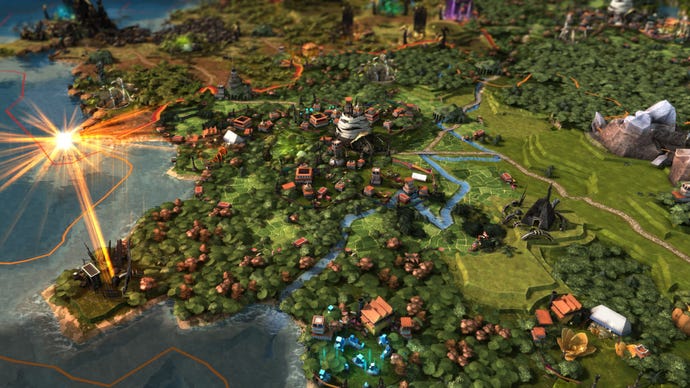RPS GOTY Revisited: 2014's Endless Legend is still one of the most vibrant, important 4X games
Though it is showing its age compared to Humankind
It's impossible to determine just how long ago 2014 was. Wisdom would dictate it sits around the 9 year mark, but no one truly believes that. Endless Legend? That was no more than two years ago, and I'll throw hands if anyone suggests otherwise. But apparently enough time has passed that just about every 4X game that came out that year has now been superceded by a newer title in the series. Civilization: Beyond Earth, Galactic Civilizations 3, Age Of Wonders 3, and Endless Legend made 2014 an incredibly strong year for strategy games, but nowadays, who really still plays these older entries?
I don't mean to sound derisive. It's a sombre truth. At 233 hours, I've put more time into Endless Legend than any other 4X strategy game in my Steam library, and loved every minute of it. To this day it's still the best in the genre when it comes to sparking the imagination of my chronically fantasy-loving brain. The music, the amazing variety in terrain and units, the sheer quantity of words bringing to life every last quest, minor faction, creature, and environmental anomaly. It's a simply splendid game. The question is whether it's still worth playing today.
Amplitude blew us away in 2014. Before, they were just known for Endless Space. Then suddenly, wham! Endless Legend and Dungeon Of The Endless are both released in the same year, cementing Amplitude as absolute masters of three things: incredible music, lovely UI design, and meaningful innovations in whatever genre they choose.
Endless Legend was the first game I know to separate each of its procedurally generated hex-based world maps into regions, and only allowing one city per region. Coupled with this, it was the first 4X I played that allowed me to expand my cities across multiple tiles. Before, the only thing telling me that one city was a megatropolis and another was little more than a dusty mining town were the numbers on the screen above the cities. In Endless Legend, you could see the difference. You could see at a glance whether that opposing city on the horizon was a London or a Bell End (yes, that's a real English town). It was such an inspired move that it was later shamelessly copied by Civilization 6 and Amplitude's later project, Humankind.

That's just one of the many ways in which Endless Legend carved its own deviant path through the 4X jungle, while others merely followed Sid Meier's mighty bootprints. In Endless Legend, there's no tech tree. Instead there are tech pools, divided by tier, with no connections or paths that you're mandated to follow. You can research any of the techs in the Tier 1 pool in any order you like. It's a level of freedom we simply weren't used to seeing in 2014.
Another area where Endless Legend knocks it out of the park is the factions. Counting all the DLC content there's a total of 14 factions in the game, and it's not like in Civ where you just get a couple of bonuses, a unique unit, and a unique building. In Endless Legend you get the Roving Clans, who can move their cities at will (because their cities are built on the backs of gigantic scarabs - I mean how fucking cool is that), and are unable to declare war. Then there are the Cultists, who are confined to just one super-city for the entire game but are able to make special use of minor factions, bending them to their will in ways other empires cannot. What about the Broken Lords, who don't use food at all, and instead use Dust - the currency of the Endless universe - for their sustenance? Or the stealthy Forgotten, who can't research technologies?

Each of these factions has their own unique main questline which takes you through a deep story and, usually, across the entire map and timeline of your game. It's another way in which Endless Legend extends the amount of time you spend exploring its rich and fascinating worlds, and why on earth wouldn't it? The worlds are lovely. Perhaps not as visually attractive as they once were, but the sheer number of terrain types and little extra curios and anomalies makes it as much a joy to explore each world as it did nearly a decade ago.
I began a game yesterday in a chilly climate near the south pole, and quickly my army stumbled across a couple of tiles dominated by Weaver Worms - giant Dune-like worms which burrow through the ice and whose silk can be "woven into fabulous fabrics". What a lovely, creative way to give me a boost to my economy in the early-game, I thought. And there are dozens of these unusual anomalies that further diversify the landscape on top of the 50 or so terrain types that the game's engine combines in thoughtful ways to make each new game world feel lived in, and worth exploring.
Then there's the battling, which again makes as much use of the surrounding landscape as possible. Whenever you enter into battle with an enemy unit, the game automatically cordons off a handful of tiles and allows you to play a miniature game of tactics and positioning to give you an edge even over enemies with better stats than you. It's a great idea, but I could never actually get behind 100%. I think it might be more of a me thing than a fault in the game. I don't think I had the patience to really delve into the different stats, traits, and equipment of each unit, but for those who enjoy those more RPG-esque elements, it makes for a far more interesting battle system than the typical "right-click on enemy with your unit and see who wins" approach. I think the system was improved greatly with Humankind though, and going back it does feel a bit clunky and dated.

That's the running theme, really. Endless Legend may have been Amplitude's crowning achievement in the context of its release year, but Humankind is the superior game in pretty much every way. Perhaps if we'd got around to doing these GOTY Revisited posts before Humankind came out, I'd feel a bit less torn about recommending Endless Legend today. But it's not just about Humankind. The whole genre is more competitive these days, with fantastic 4Xs like Age Of Wonders 4 and Old World rising every year to join heavyweights like Civilization 6 at the top.
Endless Legend had a lot of competition back in its day too, and rightly beat them all to the crown. And it's still certainly playable and enjoyable today, don't get me wrong. The issue is that all the amazing innovations that Endless Legend made have since been adopted, expanded, and perfected by others. Crucial information in Endless Legend feels a little out of reach sometimes when I'm looking at the tech screen, or a city's inner workings, or a battle map. The UI design for the time was incredible, and I still think Amplitude's "right-click to go back" philosophy is one of the greatest ideas in the history of game UIs. But there are a few more little barriers to enjoyment in Endless Legend than I remember. The soundtrack will forever remain one of my favourites and I listen to it on a semi-regular basis, but as for actually playing the game, well... I don't know. Perhaps that time has passed. For me, at least.
Does it still deserve to be called 2014's game of the year? Well to be honest, it's never been my GOTY. Transistor came out in 2014 too, and that's a close contender for my favourite game of all time, so it's a bit unfair and a bit besides the point for me to judge this. What I will say is that perhaps Endless Legend is the game from 2014 with the most memorable innovation on its genre's standard formula (except possibly the Nemesis system from Shadow Of Mordor), and it's an absolutely phenomenal achievement for its time. It's dripping with vibrancy and creativity both in its lore and atmosphere and in the inner workings of the strategy layer, and it's kept me entertained for over 200 hours spread across nearly a decade. It may not be timeless, but it'll always deserve its spot in the 4X hall of fame.


















